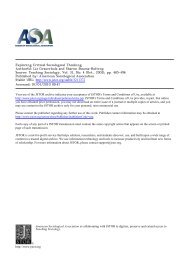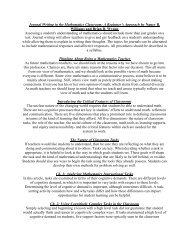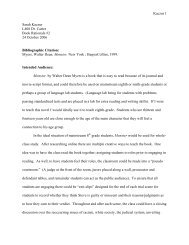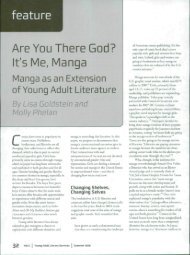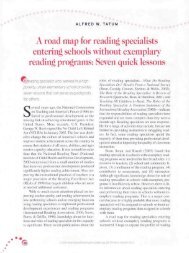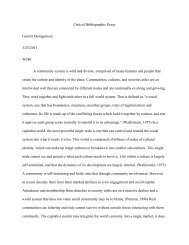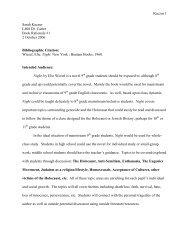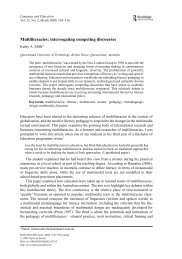Dyson 2003 Welcome to the Jam.pdf - Oncourse
Dyson 2003 Welcome to the Jam.pdf - Oncourse
Dyson 2003 Welcome to the Jam.pdf - Oncourse
You also want an ePaper? Increase the reach of your titles
YUMPU automatically turns print PDFs into web optimized ePapers that Google loves.
“<strong>Welcome</strong> <strong>to</strong> <strong>the</strong> <strong>Jam</strong>”<br />
anne haas dyson<br />
writing, though, was a separate genre. It was not a s<strong>to</strong>ry but a personal experience<br />
text that allowed Noah <strong>to</strong> fulfill <strong>the</strong> perceived expectations of school.<br />
Initially, <strong>the</strong> children participated in most official composing events primarily<br />
by drawing and talking, just as Noah did in <strong>the</strong> Space <strong>Jam</strong> event. During<br />
official events, <strong>the</strong>y organized symbol-making primarily around communicative<br />
practices not explicitly taught in school, that is, by childhood practices,<br />
like dramatic and visual play. The children’s actions, <strong>the</strong>n, indexed <strong>the</strong>ir unofficial<br />
world.<br />
After drawing (a symbolic activity sanctioned by Rita), <strong>the</strong> children wrote familiar<br />
names (e.g., of family or friends) and brief textual frames, which <strong>the</strong>y<br />
appropriated from <strong>the</strong> class-generated “things <strong>to</strong> write about” list (e.g., “I like<br />
...,”“Isaw...,”“Iwent...“).Typically, any media appropriations consisted<br />
of names and events that could be “liked” or <strong>to</strong> which <strong>the</strong>y “went,” so <strong>to</strong> speak.<br />
The writing, <strong>the</strong>n, was a sociolinguistic nod <strong>to</strong> <strong>the</strong> official world, “<strong>the</strong> social<br />
matrix within which <strong>the</strong> [print] discourse” mattered (Hanks, 2000, p. 166).<br />
Still, despite <strong>the</strong> brevity of <strong>the</strong> written texts, recontextualizing unofficial<br />
material yielded multimodal composing productions that were hybrids, however<br />
simple <strong>the</strong>y appeared. That is, <strong>the</strong>y drew from and indexed different<br />
worlds (Bakhtin, 1981). For this reason, it is possible in hindsight <strong>to</strong> see <strong>the</strong><br />
rough edges where different kinds of cultural material met and from which<br />
tensions would arise. Symbolic tensions, important in all <strong>the</strong> children’s case his<strong>to</strong>ries,<br />
seem inherent in Noah’s juxtaposition of a drawn s<strong>to</strong>ry and a written<br />
personal experience. Indeed, it would seem difficult for even a highly experienced<br />
s<strong>to</strong>ry writer <strong>to</strong> verbally translate <strong>the</strong> visceral experience of an arm<br />
stretching unexpectedly through space, a ball tracing an arc in <strong>the</strong> sky, or even<br />
a face expressing joy; exaggerated movements and facial expressions are <strong>the</strong><br />
prime province of animation, not of words.<br />
The children’s brief efforts also suggested social tensions between official<br />
and unofficial worlds. For example, <strong>the</strong> “truth” in <strong>the</strong> bro<strong>the</strong>rs and sisters’<br />
world was a playful truth that accomplished <strong>the</strong> serious work of social connection;<br />
it was not, however, <strong>the</strong> truth assumed in <strong>the</strong> official world when a personal<br />
experience was reported. Denise and Vanessa, for instance, each wrote<br />
that <strong>the</strong>y “went” <strong>to</strong> <strong>the</strong> o<strong>the</strong>r’s house, something <strong>the</strong>y never did at all (as confirmed<br />
by <strong>the</strong>ir parents); <strong>the</strong>ir official personal experiences were bits of fiction.<br />
Finally, ideological tensions were evident <strong>to</strong>o. Noah twice wrote that he<br />
“saw a good boy.” The boy was good, he <strong>to</strong>ld me, because he had a “water gun”<br />
(which, in his picture, was shooting bullets, a banned kind of classroom play).<br />
These kinds of rough edges in children’s work sometimes became more expansive<br />
communicative and problem-solving spaces. For this <strong>to</strong> happen, children<br />
had <strong>to</strong> orchestrate any talking, drawing, and writing within <strong>the</strong> frame of a<br />
particular practice (see <strong>Dyson</strong>, 1989). When that happened, rough edges between<br />
media and between worlds were not so easily smoo<strong>the</strong>d over, as I illustrate<br />
below.<br />
347



